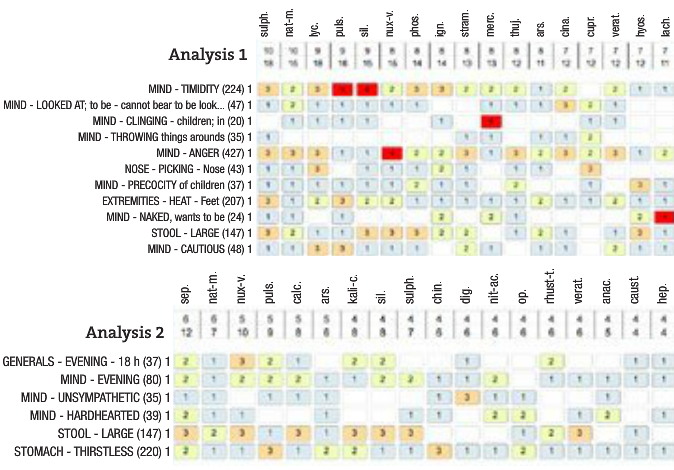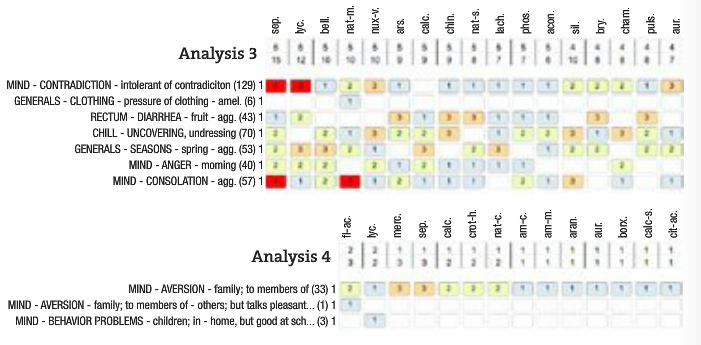Joseph Kellerstein, DC, ND
May 2004
Camille was first seen, with her mother in hand, at the tender age of 3 years. To be more precise, she was 3½.
Mom describes Camille as being very happy. However, there is a serious side. In social situations, Camille is terribly shy. In fact, this emotion can manifest more as “nervous and angry.”
It takes a long time for Camille to make eye contact, especially with her peers. She becomes quite clingy to her mother in situations where social interaction is expected.
When it comes time for playgroup, Camille wants to stay home. She has outbursts of showing anger and throwing things.
“After being surprised or frightened, for example by a frog hopping in front of us, she will have a crying fit,” said her mother. In other observations, Camille likes to play with her mom’s hair. She is an avid nose picker.
Camille learned to speak in full sentences by age 1½ years. She loves olives and hates parsley. She exhibits thirstlessness.
For about 1 year now, Camille has had an imaginary friend around. Since the birth of her younger brother, some additional anger issues have arisen.
Camille’s feet always feel hot. She loves to be naked and has huge bowel movements.
That is all I had. The case felt scattered, but I followed Hahnemann’s advice in giving the most similar remedy I could see, which was 1 dose of Pulsatilla 10M.
August 2004
Camille’s mother reports that her daughter seems more comfortable with her friends at the park. She is generally less apprehensive in new situations. She no longer wraps herself around her mother’s leg.
Camille has had a lingering cough for about 2 weeks, which is described as being loose and hard and as occurring only at night for the first 5 days. She would not wake from the cough, despite its strength.
No remedy was apparent. I administered another dose of Pulsatilla.
September 2008
Camille’s mother reports that there have been some really dramatic behaviors. Her daughter is aggressive and “nasty,” especially during the evenings between 6 and 7 pm. A couple of times, Camille seemed frightening and “evil.” She shows a lack of empathy.
Camille has had large loose stools. Again, she seemed thirstless.
The hard-heartedness of Camille struck me. It was especially concerning in view of her lack of response to other children who hurt themselves. I prescribed Anacardium 200C.
May 2009
Camille has had frequent nasal congestion, which starts with 2 days of sneezing. The taps are open and running. The mucus quickly thickens and turns yellow. She then becomes tearful and quick to anger. Whining is incessant. She insists that her pants have to fit tightly around the waist.
It is notable how quickly Camille can become angry. She kicks when angry.
I saw no image in the repertory chart that was relevant to the recent coryza. However, the picture was to some degree reminiscent of Pulsatilla, so I went back to a known simile and repeated the remedy.
May 2010
Mom’s recollection was that Camille’s coryza resolved quickly with Pulsatilla, although her daughter’s other symptoms had not. Neverthess, she had undertaken to repeat the remedy without consulting.
Camille was showing lots of anger and frustration and was quick to tears. She was physically aggressive with younger kids and with her mom, a symptom that had recently been escalating.
The sensory issue is quite intense. Camille’s clothing must always fit tightly; otherwise, she complains that it does not feel right. If her clothes do not fit just so, she will “stop, drop, and wail.”
Camille’s mood turns very quickly to one of frustration. Beginning to weep, Mom laments that it is very difficult to manage. She recounts lots of yelling and perceives that everything is so blown up. Camille will sometimes laugh if another child gets hurt.
It is May, so seasonal discharge is under way. When the weather recently turned cooler, Camille really felt it. She wanted more bedcovers.
Camille’s schoolwork was good. The teachers seem impressed with her academic performance.
Loose stools continue. This is especially so after consumption of fruits.
Mornings are horrible with respect to behavior. Attempts by her mom to console her make Camille violent.
Although Nux is absent from the rubric, it is strong in “agg,” and I see “pressure of clothing–amel.” I had noted from a materia medica lecture that Nux prefers “fitted clothing.” In view of the chilliness, anger, and aggravation in the morning, I gave Camille Nux vomica 200D.
There was no response to this remedy. Nor was their a response to the Staphysagria that I prescribed later in June.
October 2010
Camille is a real challenge. The pediatrician would like a behavioral assessment. She is miserable, angry, and aggressive. Every day is an intense situation.
In contrast, her mom understands that at school Camille is responsible, respectful, and actually brilliant, doing advanced work. Camille’s schoolwork is earning her awards!
Her mother perceives that if she is not with Camille, there are no worries! But when Camille comes home, mom asks herself “Who is this person?”
After school, Camille is explosive. There are tears. She will punch or kick anyone in her path! At the slightest tease, the result will be inconsolable tears and anger.
Camille loves to be naked because she says her clothes are not comfortable. To be comfortable, they must be tight. Mom cannot get her into proper clothing. She prefers to wear the same capri pants that she wore 4 years earlier.
The noise of a hockey game is intolerable to Camille. She just “flips” with anger and is uncontrollable, with loud wailing, kicking, and throwing.
The contrast of the angel away from mom and home and the devil at home was certainly compelling. I used the rubrics.
Fluoricum acidum came to mind from the previous rubrics. Most notable was her affinity for tight clothing.
Now on to the materia medica:
Great disposition, when alone, to repulsive fantastic imaginations, particularly in regard to persons with whom he stands in near relations, or with whom he is connected; it seems, for example, as though he must get rid of all the servants, children must go out of the house, a betrothal must be broken off, a marriage should be dissolved, etc.
Allen
During the fourth week very irritable towards people, even to the greatest hatred, which he does not hesitate to give vent to in words, but as soon as he sees them everything is forgotten, and he has an entirely different opinion of them.
Allen
Feeling of indifference towards those he loves best, has no objection to their presence but does not care to converse with them, yet if strangers or mere acquaintances come in will enter into animated conversation.
Aversion to his own family, bordering on insanity.
I prescribed Fluoricum acidum 200C.
What followed was 2 weeks of hell for the parents. I had not seen such aggravation after a remedy in this patient or any indicator of sensitivity. The potency was too high. After an adjustment, there was clear improvement in all areas.
Here we have another persistent case of “physician failure.” I was unable to sculpt a clear remedial image until I had the clothing symptom and the mind symptom of “Aversion to his own family, bordering on insanity,” and what a whopper that is! In addition, we find in the repertory “but talks pleasantly to others.”
Was it really a case of physician failure? My much downtrodden ego says no! In fact, it was a defective case, one that did not sufficiently evolve to show enough peculiarity until that identifying mental symptom was in bloom.
Could I have found this remedy sooner? I might have by ranking the need for tight clothing higher and by using the rubric “pressure of clothing–amel.”
I was feeling a bit cowardly to do so until the clothing symptom got totally out of hand, and then I unsuccessfully tried Nux. After this, I did include the symptom.
Hahnemann tells us in the Organon (you remember the reading that so reliably put you to sleep) that, if we have a case with insufficient information to identify a remedy with certainty, we should give the most related remedy and stay on course, knowing that a more closely indicated remedy will show itself in due course. We should be ready to perceive this new image. This was that kind of experience for me.


 Joseph Kellerstein, DC, ND graduated as a chiropractor in 1980 and as an ND in 1984. He graduated with a specialty in homeopathy from the Canadian Academy for Homeopathy, and subsequently lectured there for two years. He also lectured in homeopathy for several years at CCNM; for eight years at the Toronto School of Homeopathic Medicine; and for two years at the British Institute for Homeopathy. Dr. Kellerstein’s mission is the exploration of natural medicine in a holistic context, especially homeopathy and facilitating the experience of healing in clients. Dr. Kellerstein is presently teaching a post-grad course in Hahnemannian prescribing with Dr. Andre Saine. Its mission is to promote excellence in the basics of homeopathic prescribing; case taking; repertory; Organon as applied to real-life practice; and case analysis skills via modeling the masters. The course runs for three years; distance learning is available. Students can preceptor in Dr. Kellerstein’s clinic, and mentoring is available.
Joseph Kellerstein, DC, ND graduated as a chiropractor in 1980 and as an ND in 1984. He graduated with a specialty in homeopathy from the Canadian Academy for Homeopathy, and subsequently lectured there for two years. He also lectured in homeopathy for several years at CCNM; for eight years at the Toronto School of Homeopathic Medicine; and for two years at the British Institute for Homeopathy. Dr. Kellerstein’s mission is the exploration of natural medicine in a holistic context, especially homeopathy and facilitating the experience of healing in clients. Dr. Kellerstein is presently teaching a post-grad course in Hahnemannian prescribing with Dr. Andre Saine. Its mission is to promote excellence in the basics of homeopathic prescribing; case taking; repertory; Organon as applied to real-life practice; and case analysis skills via modeling the masters. The course runs for three years; distance learning is available. Students can preceptor in Dr. Kellerstein’s clinic, and mentoring is available.

